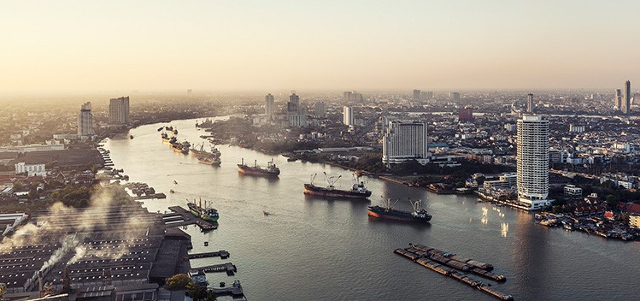Description
The 2011 flood in Thailand was ranked as the world’s fourth costliest disaster over the period 1995 to 2011. The maximum ever recorded flood of 2011 was accounted by the total amount of 1,439 mm rainfall which was 143% higher than the average rainy season between two decades from 1982 -2002. The total water volume surpassed the 10 billion m3 storage capacity of the Bhumipol and the Sirikit Dams in Chao Phraya River, reaching 15 billion m3 in early October of 2011. The extreme incidents combined generated large water volume that breached the reservoirs capacities and caused overtopping of the dams – consequently releasing tremendous floodwater downstream and amplified the inundation area lying below including Bangkok Metropolitan Area (BMA).
Action taken
The actions taken have been categorized into 3 i.e. Before, During and After the flood. Different interventions were carried before the occurrence of the flood, during and even after the floods. Department of Drainage and Sewerage (DDS) had the main responsibility in flood regulation of the BMA. Underlined with the perception to protect and drain floodwater out of the city as fast as possible, the agency emphasized the structural means of dykes, levees and floodwalls as the main prevention measures. After extensive flood damage in 1995 under the king’s advice, several authorities convened for flood mitigation measures including the assistance from the Chaipattana Foundation, a NGO established in 1988 to develop projects of national and social benefit.
To prevent floodwater to spread to East of Bangkok, the DDS build flood defense dikes beside the Rangsit Canal located in Lak Hok Sub District (beside the Hok Wa Canal and along the royal initiative water ridge). In addition, sandbags were erected along the Phaholyothin Road starting from the Rangsit Bridge to the Prapa Canal. The temporary dike (8.2 km long and 3 m above MSL) later failed in its operation to protect Bang Khen Bueng Kum, Lad Phroa and Khlong Sam Wa districts from being flooded.
The Strategic Committee for Water Resource Management SCWRM collaborated with the Japan International Cooperation Agency (JICA) assigned to conduct the comprehensive flood management plan for the Chao Phraya River Basin under the supervisory panels consisted of the representatives from the Royal Irrigation Department (RID) and the Department of Water Resources (DWR). After the 2011 flood damage, the SCWRM and the NESDB published an outline to the national Master Plan for Water Resource Management with the strategy to adopt the King’s initiatives and the Philosophy of Sufficiency Economy as guiding principles in the drafting.
Lessons learnt
- Flooding is familiar annual occurrence in Thailand and is particularly common in the lower Chao Phraya River, yet, the urban population became increasingly less accustomed to its occurrence due to the detachment from natural water cycle by new development of urban settings. All of which contributes to the lack of awareness to the water-related hazard, uncertainties and growing concerns by the both unaffected urban residents and flood- affected communities.
- Various committees established by executive decrees, such as the SCWRM, have been created under different governments for different occasions which rely solely on the executive power to implement actions. Bureaucratic political process needs to be overcome with cross-cutting horizontal governance and management such as the capacity building in the residents, public and private sectors as well as across the government departmental agencies.
- Ad-hoc and transitory measures are often evoked after crisis than before the crisis. The existing National Water Resource Committee (NWRC) were less prepared for flood management. The establishment of a new body, SCWRM which is headed by the Prime Minister duplicate roles and responsibilities.
- Numerous structural measures were emphasized in several sub-projects following the initiation of the plan to prevent and mitigate the floods in the Chao Phraya River Basin with insufficient considerations of the impacts to the surrounding areas. Dams, dikes and levees often failed in their operations and cannot withhold the increase uncertainties of the natural phenomenon. The failure, with no flexible mitigation alternatives, contributed to greater damage after floodwater broke out.

